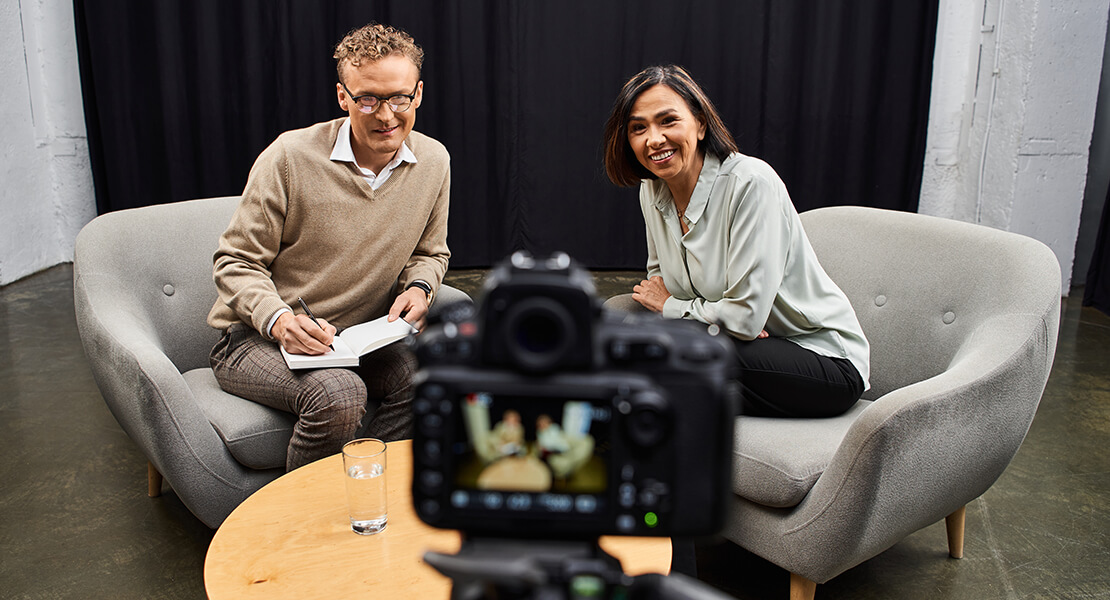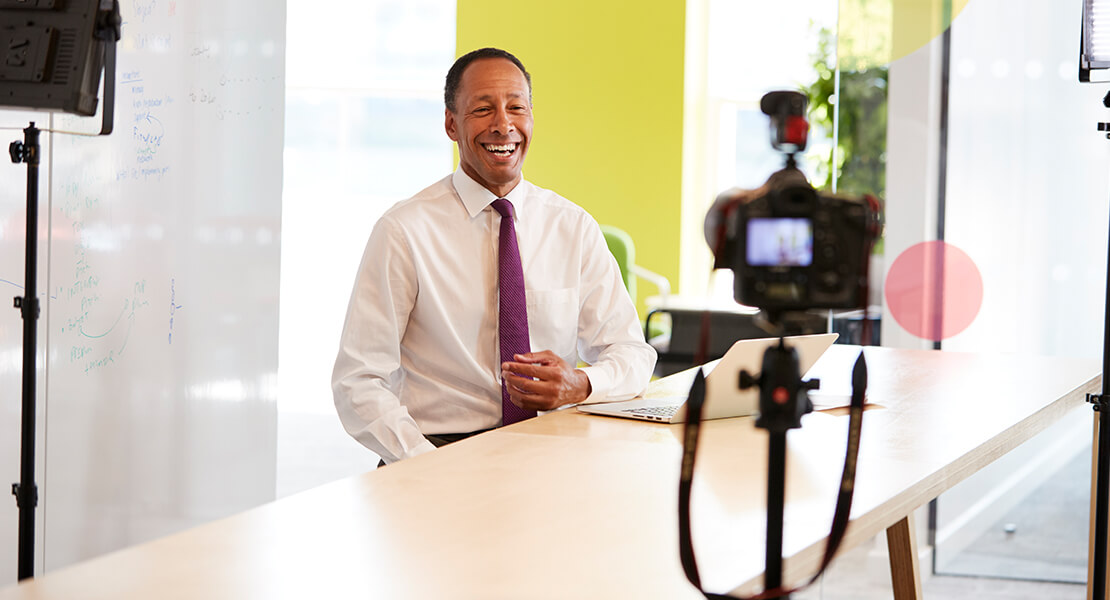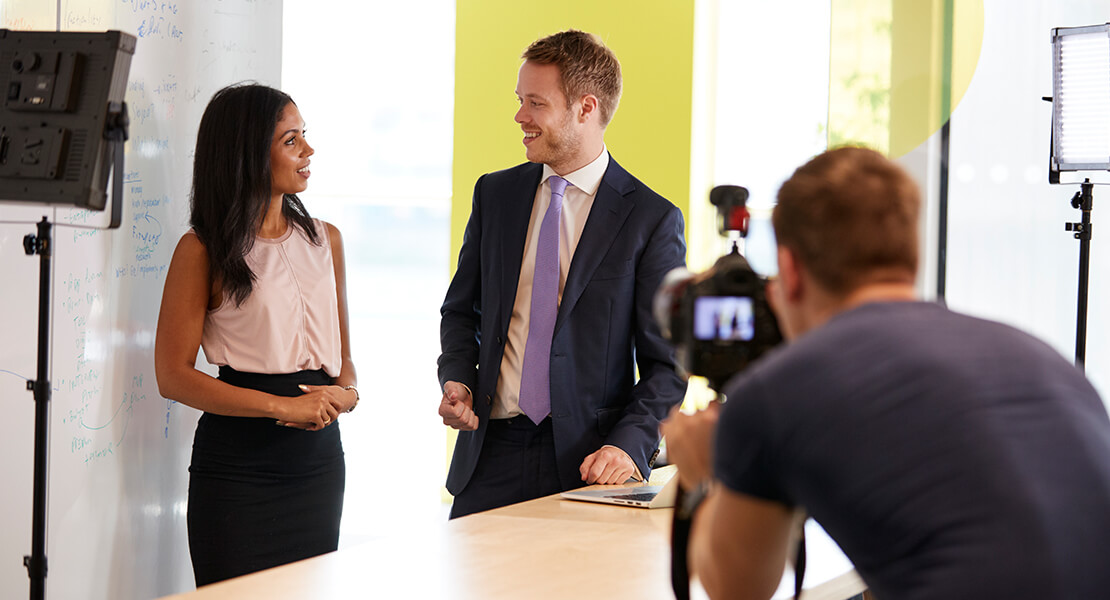
Interview videos can be incredibly powerful—but only when they feel authentic, engaging, and well-crafted. Too often, interviews come across as stiff, lifeless, or overly scripted. The good news? It doesn’t have to be that way. Here are 9 best practices to make sure your interview content feels dynamic, natural, and anything but boring.
1. Choose the Right Interviewee
It might sound obvious, but the person you put in front of the camera makes or breaks your interview. Choose someone who’s not only knowledgeable, but also comfortable speaking and willing to share real insights. They don’t have to be a polished speaker—what matters more is that they’re genuine, passionate about the topic, and able to speak in their own words.
Avoid choosing someone just because of their title. If they’re flat or overly cautious in their delivery, your audience will tune out. Always pre-interview your guest off-camera. Have a chat, ask a few of the questions you plan to use, and pay attention to how they speak. Do they come alive when they talk? Are they using real examples? You want warmth, expression, and that little spark of personality.
Also, make sure they’re briefed, not scripted. The more natural the conversation, the better the final cut will feel. And don’t underestimate the power of coaching. A little guidance and reassurance can help even a nervous subject shine on camera.

2. Ditch the Corporate Backdrop
Let’s be honest—there’s nothing more uninspiring than a grey wall, a soulless boardroom, or a static office shot. If you want your interview to feel interesting, choose a location that adds context and character. This could be a working environment, a creative space, or even outdoors—anywhere that reflects the tone of the conversation or the personality of the speaker.
The space doesn’t have to be flashy. It just needs depth, texture, and visual interest. Backgrounds that show a bit of story—books, artwork, natural light, or soft furnishings—help your subject feel more at ease and give the viewer something to connect with. Avoid distractions, but embrace subtle movement or depth that gives the frame life.
Sound matters here, too. A great-looking location is no use if you’re battling background noise. Always do a sound check before you shoot, and if you’re filming in a public or semi-public place, plan for interruptions. Bring an extra mic, some absorbent materials, and have a backup location in mind.
The takeaway? Your setting should complement the conversation, not compete with it. Make it feel lived in, real, and relevant—because sterile just doesn’t cut it anymore.

3. Use a Conversational Setup
Nothing drains the life out of an interview faster than a rigid question-and-answer format. If you want your interview to feel lively, aim for a conversation, not an interrogation. Position yourself off-camera, close to the lens, and speak with your subject like you would over a coffee—not like you’re reading from a clipboard.
Start with some warm-up questions before filming officially begins. Get your interviewee talking casually so they relax into the moment. Often, the best responses come after a few minutes of gentle chat—not in the first take. Don’t be afraid to reframe questions if their answers feel forced. A simple “Tell me about…” or “How did that feel?” can work wonders.
Let the interviewee finish their thoughts before jumping in. Leave a beat at the end of their answers—it makes editing cleaner and avoids interruptions. And when they say something brilliant, react naturally. Smile, nod, engage. Your reactions, even off-camera, help maintain momentum and make the person feel heard.
If you’re filming a more formal interview, consider having a second person on set just to keep the energy up—a producer, a friend, someone who can lighten the mood or crack a joke if needed. A relaxed subject always delivers better content.
4. Frame It Creatively
Framing can completely change how an interview feels. While the classic mid-shot, eye-line-to-camera-left framing still has its place, you can do more. Experiment with angles, lens choice, and composition to bring a more cinematic, story-driven feel to your footage.
Use the rule of thirds to give your subject space. Play with over-the-shoulder shots or include subtle foreground elements to add depth. Think about symmetry if you’re going for a more polished, documentary feel, or go off-centre for a relaxed, informal vibe. Don’t just plonk your subject in front of the lens—build a frame around them that adds interest and context.
Camera movement can also work wonders. A slow push-in during a powerful moment can add intensity. A gentle slider shot creates a sense of motion without distraction. Just make sure movement feels intentional—not dizzying.
And don’t forget headroom. Too much space above the subject’s head can make them feel lost in the frame, while too little can feel claustrophobic. Keep your framing clean, and constantly check your monitor. What looks fine to the eye may not translate to screen.
Framing is a storytelling tool—use it with purpose, and your interviews will feel immediately more polished and professional.
5. Light It Like a Story, Not a Statement

Lighting isn’t just a technical step—it’s part of the emotional tone of your interview. Harsh overhead fluorescents? They’ll flatten your subject and suck the life out of the frame. Instead, aim for soft, directional lighting that highlights the face without washing everything out. Natural light from a window can work beautifully if it’s diffused with a sheer curtain or reflector. If you’re using artificial lights, go for a soft key light at a 45-degree angle and a fill to reduce harsh shadows.
Don’t forget about background lighting, either. A warm lamp in the distance or a splash of colour on a back wall adds depth and visual interest. If you want to get cinematic, add a hair light or edge light to subtly separate your subject from the background.
And always light for the mood you want. Is this a relaxed, human-centred story? Keep it soft and warm. Is it a more serious corporate message? You might want cooler tones and sharper contrast. Either way, avoid flat lighting—it’s the quickest way to make your video look dull and lifeless.
A well-lit frame doesn’t just look good—it feels good to watch. And when your subject is well-lit, they tend to feel more confident too.
6. Shoot with Two Cameras (If You Can)
If you’re aiming for a dynamic, professional-looking interview, using two cameras is one of the simplest ways to add variety and energy to the final edit. A static one-camera setup can work, but it often limits your options. With a two-camera setup—typically a wide shot and a close-up—you can cut between angles to maintain interest, highlight emotion, and remove awkward pauses or stumbles without noticeable jumps.
This is especially useful if your subject repeats themselves or loses their train of thought. You can clean it up in post by switching angles, making the final result feel seamless and natural. It also allows you to match the energy of the conversation, tightening the pacing and keeping your viewer engaged.
Position your cameras slightly off-axis—one directly focused on the subject’s face, the other at a 30 to 45-degree angle. Match exposure and colour temperature between both cameras to avoid jarring shifts in tone.
And if you’re only working with one camera, consider filming the full interview in a wide shot, then asking the subject to repeat key answers for a tighter close-up. It takes a bit more time, but in the edit, it pays off massively.
7. Get Great Sound—or Don’t Bother
You can forgive slightly shaky camera work or less-than-perfect lighting, but poor sound kills an interview. Nothing says “amateur” like background hum, muffled voices, or echoey audio. Invest in a quality lapel mic or boom mic, and always monitor sound with headphones during the shoot—never assume it’s “probably fine.”
Record a few seconds of room tone before the interview starts, so you can clean up the background in post. And always check for interference—mobile phones, Wi-Fi, or nearby traffic can ruin an otherwise perfect take.
Place your mic carefully. A lapel mic should be clipped mid-chest, away from jewellery or rustling clothing. A boom mic should be close, but out of frame, ideally overhead and angled towards the speaker’s mouth.
Background noise is one of the hardest things to fix after the fact, so do your best to get it right on set. If you’re filming outdoors or in a lively space, have a Plan B ready—whether that’s a quieter spot nearby or a noise reduction strategy in post-production.
Great sound makes your video feel professional—and more importantly, it ensures your message is heard, clearly and confidently.
8. Capture B-Roll to Bring Stories to Life
Even the most engaging speaker can’t carry an entire video with talking head footage alone. That’s where B-roll comes in—supporting footage that visually illustrates what your interviewee is talking about. Whether it’s shots of them at work, their environment, products, hands moving, or close-ups of relevant details, B-roll makes your story richer and far more watchable.
Plan your B-roll shots around the key topics discussed. If they mention a process, a memory, or a space—film it. Show rather than tell. Audiences remember visuals far better than words alone. B-roll also gives you editorial flexibility. It allows you to cover cuts, remove filler words, and improve pacing without obvious jump cuts.
Shoot more than you think you’ll need. You can always trim later, but you can’t edit in footage you didn’t shoot. Try different angles—wide, medium, close-up—and think about movement. A gentle pan or handheld motion can give your visuals a more organic feel.
Well-planned B-roll gives your video polish, depth, and emotional connection. It turns a basic Q&A into a visually engaging, narrative-driven piece that people actually want to watch to the end.
9. Keep the Edit Tight and Purposeful
Editing is where everything comes together—and where interviews often fall flat if you’re not intentional. A strong edit does more than just trim excess. It shapes the narrative, highlights the emotional beats, and keeps your audience hooked from start to finish.
Start by identifying the core message. What do you want viewers to walk away with? Then trim anything that doesn’t serve that message. It’s tempting to include every good soundbite, but brevity wins—especially online.
Use your camera angles wisely. Cut between shots to maintain flow and avoid monotony. Bring in B-roll to add texture and visual breaks. Add light background music only if it enhances the tone—never distracts.
Pay attention to pacing. Too slow, and viewers will drift off. Too fast, and you risk overwhelming them. Find a rhythm that feels natural and mirrors the tone of the interview. And don’t forget the ending—wrap with a strong closing line or call to action that leaves the audience with clarity.
A great edit respects the viewer’s time and rewards their attention. Keep it sharp, keep it human, and always cut with purpose.
10. Direct with Confidence—but Keep It Light

The role of the interviewer or director on set is hugely underrated. Even with a great setup, strong lighting, and a sharp script, the final result can fall flat if your subject feels stiff, unsure, or self-conscious. Your job? Guide the conversation without controlling it. Be present, calm, and clear in your direction—but avoid being overly formal or robotic.
Start by setting the tone as soon as they arrive. Offer them a tea or coffee, have a friendly chat, and explain what the shoot will involve. Let them know it’s okay to mess up, pause, or rephrase anything. That permission takes the pressure off immediately. Reassure them that everything can be edited, and that you’re here to make them look and sound great.
During the shoot, keep your direction simple and positive. Praise good answers, repeat key questions if needed, and gently guide them back on track if they drift. If energy drops, suggest a quick break or a change of scenery.
The key here is balance. Be clear and in control, but not demanding. Make the subject feel like a collaborator, not a prop. When someone feels comfortable and supported, it shows on screen—and that natural, confident energy is what keeps viewers engaged.
11. Use Visual Prompts and Reminders
Not everyone is used to being on camera, and even the most confident speaker can go blank mid-sentence. One helpful way to keep your interviewee relaxed and on track is to use visual prompts—simple notes, images, or keywords positioned just out of frame.
These cues can help jog their memory or keep them focused on the point without needing to memorise answers or awkwardly read from a script. It’s especially useful in content-heavy interviews where you want them to cover specific topics without sounding rehearsed.
Use a cue card with a few bullet points, or tape keywords next to the lens if you’re filming solo. For remote setups, share a Google Doc on a second screen with talking points they can glance at naturally. Just avoid anything too text-heavy—this should be a gentle reminder, not a script to read from.
Visual prompts are also great for non-verbal energy cues. A note saying “Smile” or “Pause” can subtly encourage more natural delivery. You can even use objects or props to spark stories—something as simple as a photo or item can help unlock emotion and authenticity.
At the end of the day, it’s about setting up an environment that supports your subject, keeps them engaged, and helps them deliver their best.
12. Respect the Viewer’s Time
This might sound obvious, but it’s easily overlooked: your audience’s time is valuable. If your interview drags on, repeats itself, or rambles without a point, viewers will click away—no matter how lovely the lighting is. That’s why it’s crucial to keep things focused, concise, and purpose-driven.
Before you even hit record, have a clear sense of what you want the viewer to take away. What’s the story, the insight, the emotion? Then shape your questions around that. Ask yourself, “Does this moment serve the story?” If not, cut it. Great interviews don’t include everything—they include the right things.
Respecting the viewer’s time also means front-loading value. Don’t take five minutes to get to the point. Hook your audience early with a powerful quote or an emotional insight. Then use pacing, structure, and editing to keep them engaged throughout.
Visuals play a part, too. Keep the screen moving with purposeful cuts, B-roll, and text overlays if needed. Subtle graphics or name captions help add context without overwhelming the viewer.
Ultimately, it’s not just about respecting the clock—it’s about respecting your audience. Deliver something meaningful, make it enjoyable to watch, and don’t overstay your welcome. When you do that, people not only stay—they share.
Final Words
Interview videos have so much potential—but only if they’re crafted with care. When done right, they feel more like conversations than content. They connect, inform, and build trust. But getting to that point takes more than just turning on a camera and hoping for the best.
It’s about being intentional at every stage—from choosing the right speaker and setting the tone, to lighting the shot, capturing great sound, and shaping the story in the edit. It’s also about making your subject feel seen, heard, and supported—because that comfort translates directly to the screen.
Follow these best practices, and you’ll start creating interviews that people actually want to watch. Not just because they’re well-shot, but because they’re human, engaging, and full of real value.
So, next time you’re behind the camera, remember: avoid the formulaic. Embrace the authentic. And always film with purpose.
That’s how you take an interview from something people tolerate—to something they remember.

